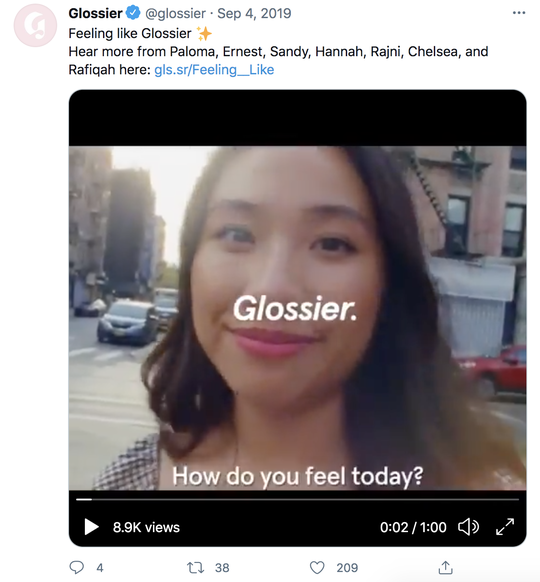5 Ways to Film and Distribute an Ad Campaign with Minimal Funding
From the moment an ad campaign goes live, marketers start tracking metrics like engagement, click-through rates, and customer acquisition costs (CAC) to gauge what their next strategic move should be.
If your campaign is delivering great results, you might put more ad spend behind it for a longer period of time. If the results are subpar after a few days or a week, you might nix the campaign altogether and rethink your approach.
You want to save as much money as you can while still converting more customers, especially when budgets are tight. The goal here is to keep CAC low, but this is often easier said than done.
In this post, we'll share five ways that you can lower production and distribution costs for your video ad campaigns. That way, you can create quality ad content without overextending your budget and racking up unnecessary costs.
1. Re-share User-Generated Content
Did you know that campaigns with user-generated content can generate 29% more conversions than those without?
By encouraging current customers to create and share videos that endorse your business, you're able to:
- Put your business in front of new and diverse audiences, increasing brand awareness
- Improve brand reputation and consumer trust
- Build up a content reservoir of videos that you can re-share anytime
- Save money, time, and resources
People trust the recommendations of other people more than they do brands. And while you can (and should) leverage influencer partnerships for ad campaigns, you can save time and money when you involve your own customers in the campaign.
The beauty brand Glossier is known for showcasing real customers in their ad campaigns and re-posting user content on social media. Take the "Feeling like Glossier" campaign, for example.
The entire campaign centered on real people from diverse backgrounds. Not only was this campaign successful, but the brand continues to encourage users to create content using hashtags like #GlossierIRL so that this content can be re-shared by Glossier.
One of the best ways to involve your customers in your next ad campaign is to incentivize them through giveaways and user spotlights. For example, when they share a self-made video and use a branded hashtag, they could enter to win a free yearly subscription or product package.
This type of ad strategy is cost-effective brand-building for you, but it also benefits your customers.
2. Consider Using Alternative Filming Gear
User-generated content adds quality and authenticity to ad campaigns, but it's not a substitute for the branded content you plan, produce, and distribute.
When it comes to video production, there is a misconception that businesses need a filming setup of Hollywood production proportions to create great content.
In all actuality, you can produce meaningful ad content for your website, social media, Google, etc. without spending hundreds of thousands of dollars to fund a fully staffed in-house production studio.
And that's because foundational videography skills, a selection of basic gear, and a video editing software is all that you really need to make video ads.
Minimal funding requires some flexibility on your part, which is why it's important to explore your alternatives to the traditional video production process.
Instead of investing in expensive camera gear that is difficult to learn and operate, you can film the content you need with the smartphone device you already have. (Here's just one example of a smartphone-produced ad.)
And if you don't have room in your budget to rent or buy gear like a dolly setup or camera stabilizer, you can opt for a tripod or a DIY handheld stabilizer instead.
Creating a successful ad campaign with minimal funding is completely doable -- you may just have to cut a few corners here and there.
By using alternative filming gear, you can allocate leftover production funds to your campaign's distribution channels.
3. Book Multiple Campaign Shoots for The Same Day
As you plan out the content in your campaign, it's important that the videos you create tell a cohesive story that aligns with your team's campaign objective (i.e., to convert social media users into email newsletter subscribers, improve the click-through rate, etc.).
One way that you can film these videos in less time and with less funding is by scheduling two or more campaign shoots for the same day at the same location.
Let's say that, like Glossier, you're centering a campaign around five of your current customers.
During the pre-production stage, try to schedule most (or all) of your shoots with these individuals for the same day. So instead of booking five different locations, you can book one location and change up the set design.
This is a cost-effective solution if you need to film a lot of content in a short amount of time. Not to mention, streamlining production like this means that you can edit and distribute your ad content sooner.
4. Leverage Your Co-Marketing Partnerships
If you're looking to get more out of your ad campaigns, one way to do that is to collaborate with brands that share a similar target audience, customer base, and mission.
As part of a co-marketing partnership, you could run an ad campaign that advertises a product or service that you're launching in partnership with (and even support for) another brand.
Starbucks' #whatsyourname campaign is a great example of this:
https://www.youtube.com/watch?v=pcSP1r9eCWw
For this ad campaign, Starbucks partnered with the UK-based charity Mermaids for a limited period of time to sell their Mermaid Cookie. A portion of each sale went toward the charity's helpline support.
As part of this campaign, Starbucks showcased real people like Cairo and Eliza who share the story behind their names in 30-second videos.
Not only did this partnership benefit the charity's cause, it showed viewers that Starbucks is a company that cares about its customers and their stories.
By leveraging your co-marketing partnerships for ad campaigns, you can distribute your video ads on your partner's social media and extend your outreach to their followers as well.
Not only is this approach effective, it's oftentimes a more affordable alternative to running ads on Google and other platforms.
5. Be Selective About When and Where You Run Ads
Choosing which distribution channels you'll run your ad campaign on isn't ever a last-minute decision. You want to make sure that the channels you use have the best chance of delivering a good ROI, especially when you're working with a tight budget.
As a rule of thumb, go where your target audience goes and make sure you're not relying too heavily on just one channel. Also, don't be afraid to repurpose and reformat the footage to be distributed on different channels.
If you have a large following on social media, run a series of paid ads over the course of a week and track engagement. If you re-share a user-generated post on Facebook, boost this post to reach more people in less time.
The main takeaway -- whether you're advertising on social media, Google, or another channel -- is to closely monitor progress and test out different strategies until you find what works best for your business.
Mackenzie is a copywriter at Soundstripe, a royalty free background music company that provides filmmakers, creators, and advertisers with royalty free sports music, among other genres.



